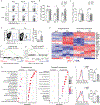Single-cell RNA-seq reveals TOX as a key regulator of CD8+ T cell persistence in chronic infection
- PMID: 31209400
- PMCID: PMC6588409
- DOI: 10.1038/s41590-019-0403-4
Single-cell RNA-seq reveals TOX as a key regulator of CD8+ T cell persistence in chronic infection
Abstract
Progenitor-like CD8+ T cells mediate long-term immunity to chronic infection and cancer and respond potently to immune checkpoint blockade. These cells share transcriptional regulators with memory precursor cells, including T cell-specific transcription factor 1 (TCF1), but it is unclear whether they adopt distinct programs to adapt to the immunosuppressive environment. By comparing the single-cell transcriptomes and epigenetic profiles of CD8+ T cells responding to acute and chronic viral infections, we found that progenitor-like CD8+ T cells became distinct from memory precursor cells before the peak of the T cell response. We discovered a coexpression gene module containing Tox that exhibited higher transcriptional activity associated with more abundant active histone marks in progenitor-like cells than memory precursor cells. Moreover, thymocyte selection-associated high mobility group box protein TOX (TOX) promoted the persistence of antiviral CD8+ T cells and was required for the programming of progenitor-like CD8+ T cells. Thus, long-term CD8+ T cell immunity to chronic viral infection requires unique transcriptional and epigenetic programs associated with the transcription factor TOX.
Conflict of interest statement
Competing Interests Statement
E.J.W. has consulting agreements with and/or is on the scientific advisory board for Merck, Roche, Pieris, Elstar, and Surface Oncology. E.J.W. has a patent licensing agreement on the PD-1 pathway with Roche/Genentech. Y. J. has stock in Cellular Biomedicine Group.
Figures







Comment in
-
TOX: a rediscovered master molecular actor to enhance immuno-oncology interventions.Cell Mol Immunol. 2020 May;17(5):558-560. doi: 10.1038/s41423-019-0276-3. Epub 2019 Sep 12. Cell Mol Immunol. 2020. PMID: 31515505 Free PMC article. No abstract available.
References
Publication types
MeSH terms
Substances
Grants and funding
LinkOut - more resources
Full Text Sources
Other Literature Sources
Molecular Biology Databases
Research Materials

